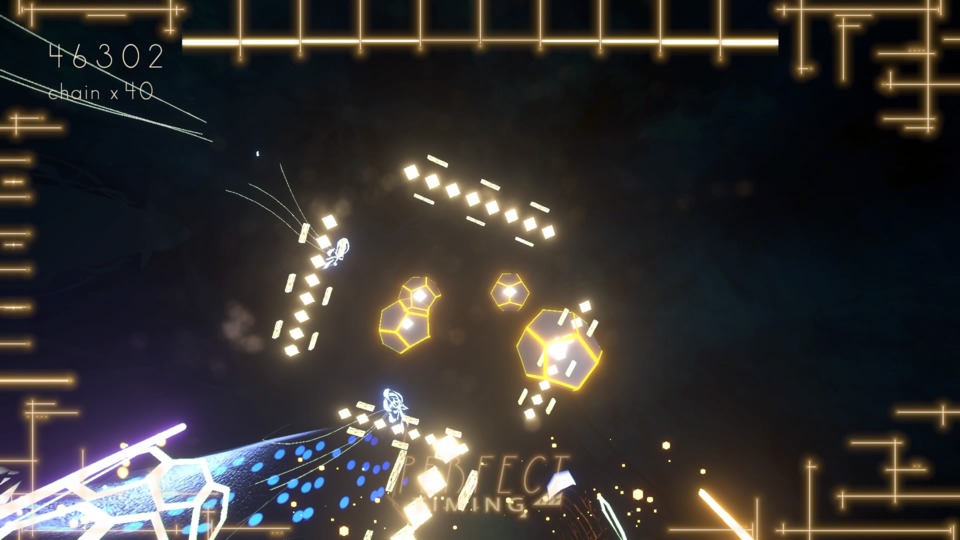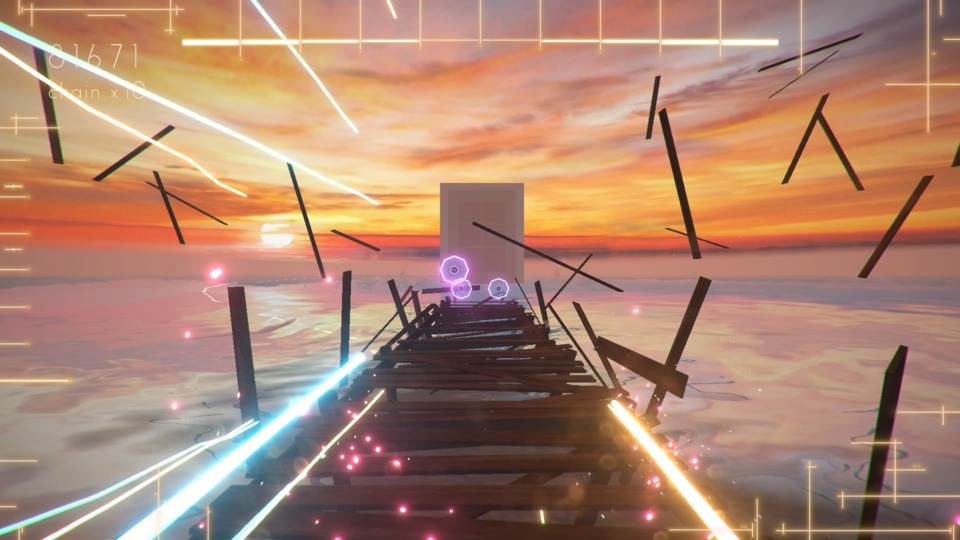Laserlife brings together an unique story and a challenging rhythm game. All with an amazing soundtrack.
It's very telling that Choice Provisions are trying to tell a meaningful and thought provoking story with Laserlife. Within seconds of booting up the game, a quote from Japanese philosopher and writer Michio Kushi comes on the screen. "Memory is the process of tuning into vibrations through space and time.". This quote is really the basis of the story concept throughout the game and it uses it to a good effect. The gameplay really helps to move it along with a nice challenge that, while initially easy to grasp in the early going, becomes more difficult the deeper in you go. It also helps that the game is beautiful to look at while playing, even though you will mostly be focused on keeping the timing in your head and making sure not to miss any fragments of memories.
The story is revolved around a long dead astronaut as it floats listlessly through deep space. As it coasts in the void, a mysterious structure comes into view and just so happens to meet with the astronauts corpse. The structure lights up in a beautiful neon color after they connect and begins to probe into this space travelers memories. After this opening, it'll open up the first of three blocks of memories for you to collect. Each block of memories have four sub-memories. Completing each of these sub-memories will unlock the next one for you to attempt. Once you beat all four sub-memories, you will be able to access the next big memory block. Each big memory block represents a moment in time about this dead astronauts time in his life.
There are three stages to every "Memory Molecule Collection" as the game puts it. The first is the actual collection part. You control two beams of laser-lights with the analog sticks on your controller and rotate the sticks in the direction of the yellow memory molecules floating in space. As the molecules float towards you on the track, you press the left and right triggers to collect the molecules to the beat of the song. The second stage is Memory Harmonization. In this part, all you need to do is guide your beams towards these targets while the memory reconstructs. The final stage, dubbed "Warp Phase", will have you dodging walls as they come at you. Timing, of course, is everything. Getting a "Perfect" timing will net you the most points while "Great" and "Good" will get you less points. With every successful collection, you will build up a score multiplier and a Sync bar. If you miss a molecule, target, or hit a wall in their respective stages, your multiplier will reset to zero and your Sync bar will take a hit. You can rebuild your Sync bar, but too many consecutive misses will drain your Sync bar rapidly and once it is empty, you fail and restart at the beginning of what stage you failed at. Once you reach the end, you infuse the memory by swirling the sticks and extract the memory from the astronaut. Here is where you get your final score and a star ranking of how well you did. As more memory blocks open up, the challenge will increase in both the speed of the game, how much to collect, and the types of molecules such as molecules that you need to hold down the triggers for.

The controls for the game are something that might seem awkward as you start, but after roughly a half hour of figuring out what to do exactly and just re-wiring your brain, you'll able to actually finish the majority of the collections without much issue. Usually if I messed up, it was because I wasn't fast enough. The motions on the analog sticks are very fluid to your movements and go where you want them to go on the screen. Likewise, the triggers are also pretty responsive.
The game itself looks fantastic and very colorful. The first stage of the Memory Collection has generally a real spacey kind of look. While collecting the molecules, off in the background, it looks like you're navigating through the cold of space with objects floating by, or seeing things that look like neurons starting to fire up and flicker back to life that looks really neat. It's the Harmonization stages though that get the most out of the gorgeous art design, however. Everything in these stages are you effectively reliving the memories and seeing what this person has seen and where he's been. It's impressive to see everything come together in these sections and is a wonderful show. While it is very colorful and bright, I did have a few moments when during faster parts, I tended to lose where my lasers went as they became a little lost in the menagerie of colors. The camera is pretty good as well, but there are times where it'll swim and sway in a direction that can mess up your perception of where your laser beams should go in order to hit your targets. After a couple times though a song, you'll generally know where you need to be to collect the molecules.
Being a rhythm game, the music would have to be a pretty important part of the product. I can say with all confidence that I absolutely love the soundtrack. It has a definite flavor of space electronica with a lot of good beats and melodies. It fits really well with the setting and is something that got stuck in my head more often than not. Tracer has put together a great collection of songs to really tie this game together. The sound design is also done well. Collecting the molecules or hitting targets offers a soft acknowledgement that doesn't block out the song and blends well with the beat of the music. Missing targets however, awards you with a sound that I would describe as a "thunk" sound equivalent to someone tapping a plastic jug with a stick. It works well to let you know you missed something.

As far as anything involving multiplayer, the game has online leaderboards for every song and every difficulty, that's it. Other than replaying songs to get a higher leaderboard score, there really isn't that much else in Laserlife. I kinda wished there were at least an endless mode or even a music player so you could just listen to the songs. It's thin on extra content which hurts the overall package. Laserlife is also short as well. I finished the story arc in about the span of two hours.
Laserlife, while a short game, was a sweet experience and worth my $14.99. I was really happy with my time with it and just came away with it feeling like it nailed it's philosophical premise and did what it set out to do. Not only that, but it did it with great visuals and an amazing soundtrack that has now found a home in a list of one of my favorite video game soundtracks of all time.